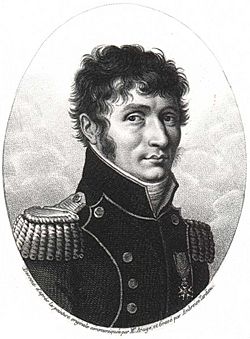Étienne-Louis Malus facts for kids
Quick facts for kids
Étienne-Louis Malus
|
|
|---|---|

Étienne-Louis Malus
|
|
| Born | 23 July 1775 Paris, France
|
| Died | 24 February 1812 (aged 36) Paris, France
|
| Nationality | French |
| Known for | Malus's law Plane of polarization Polarization of light Malus-Dupin theorem |
| Awards | Rumford Medal (1810) |
| Scientific career | |
| Fields | Physics |
Étienne-Louis Malus (born July 23, 1775 – died February 23, 1812) was a smart French scientist. He was an officer, an engineer, a physicist, and a mathematician. He is best known for his important discoveries about light.
Malus was born in Paris, France. He joined Napoleon's trip to Egypt from 1798 to 1801. While there, he was part of the math group in the Institut d'Égypte. Later, in 1810, Malus became a member of the Académie des Sciences, a famous French science group. The same year, the Royal Society of London gave him the Rumford Medal for his work.
Contents
Studying Light
Malus spent almost all his time studying light. He looked at how light rays travel and behave. He did experiments to check out Christiaan Huygens's ideas about light. Then, he wrote down these ideas using math.
Light Polarization
In 1809, Malus made a big discovery: light can become "polarized" when it reflects off a surface. Imagine light as waves. When light is polarized, its waves only vibrate in one direction. He also studied how light bends in a special way when it goes through crystals. This is called "double refraction."
Malus's Law
Malus is most famous for something called Malus's law. This law helps us figure out how bright light is after it passes through a special filter called a "polarizer." It shows how the brightness changes depending on how the polarizer is turned.
Brewster's Law
Malus tried to find a link between the angle at which light reflects and becomes polarized, and how much the material bends light (its refractive index). He found the right answer for water. But he couldn't get it right for glass. This was because the glass he had wasn't very good quality.
It wasn't until 1815 that another scientist, Sir David Brewster, used better glass. He then correctly figured out what is now known as Brewster's law. This law explains the special angle where reflected light becomes completely polarized.
How Polarization Was Discovered
In 1810, Malus was studying how light bends in two ways (double refraction). One day, he was looking through a special crystal prism at the sunlight reflecting off the windows of the Luxembourg Palace in Paris.
He was very surprised by what he saw. As he turned the prism, the two reflected light rays kept disappearing and reappearing. This meant the reflected light had changed in a way that was similar to light passing through a special crystal called Iceland spar.
Malus called this new event "polarization." At first, he thought this couldn't be explained by the idea that light travels in waves. Instead, he believed that tiny light particles, which he called "corpuscules," had a kind of "polarity," like the poles of a magnet.
Malus's Other Work
Malus also used math to study how light rays move in three dimensions. He developed a theorem (a mathematical rule) about light rays. He thought that light rays coming from one point, after reflecting off a surface, would all be at right angles to a common surface. However, this idea was later found to be incorrect when light was understood as waves.
His name is one of the 72 names written on the Eiffel Tower in Paris.
See also
 In Spanish: Étienne-Louis Malus para niños
In Spanish: Étienne-Louis Malus para niños
- Polarimeter

